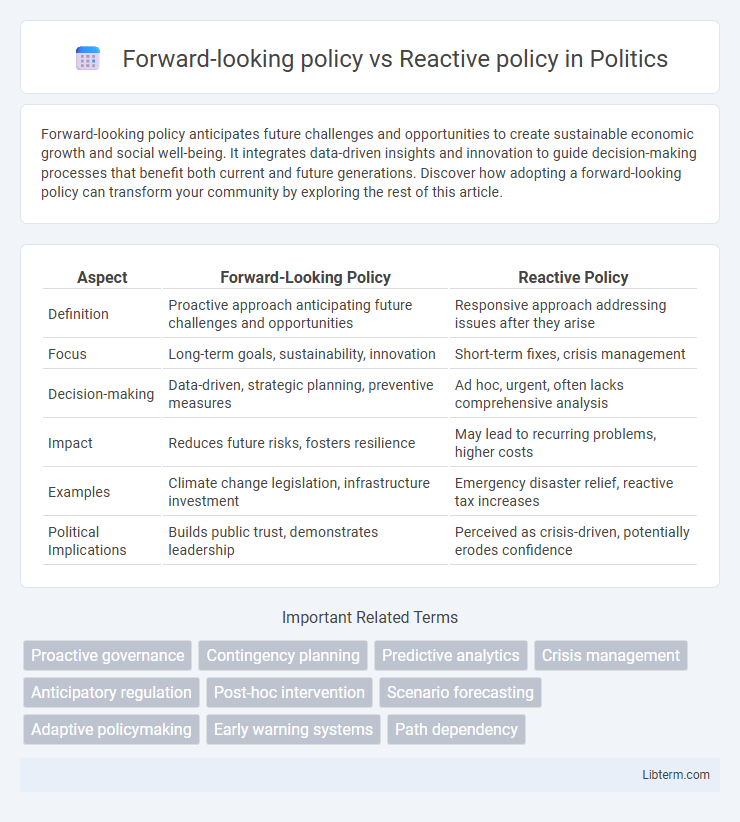Forward-looking policy anticipates future challenges and opportunities to create sustainable economic growth and social well-being. It integrates data-driven insights and innovation to guide decision-making processes that benefit both current and future generations. Discover how adopting a forward-looking policy can transform your community by exploring the rest of this article.
Table of Comparison
| Aspect | Forward-Looking Policy | Reactive Policy |
|---|---|---|
| Definition | Proactive approach anticipating future challenges and opportunities | Responsive approach addressing issues after they arise |
| Focus | Long-term goals, sustainability, innovation | Short-term fixes, crisis management |
| Decision-making | Data-driven, strategic planning, preventive measures | Ad hoc, urgent, often lacks comprehensive analysis |
| Impact | Reduces future risks, fosters resilience | May lead to recurring problems, higher costs |
| Examples | Climate change legislation, infrastructure investment | Emergency disaster relief, reactive tax increases |
| Political Implications | Builds public trust, demonstrates leadership | Perceived as crisis-driven, potentially erodes confidence |
Understanding Forward-Looking Policy
Forward-looking policy emphasizes proactive strategies and anticipates future challenges through data analysis, scenario planning, and long-term impact assessment. It enables governments and organizations to allocate resources efficiently and design sustainable solutions before problems escalate. This approach contrasts with reactive policy, which addresses issues only after they arise, often resulting in higher costs and limited effectiveness.
Defining Reactive Policy Approaches
Reactive policy approaches are strategies implemented in response to events or problems after they occur, focusing on immediate issues rather than anticipating future challenges. These policies prioritize short-term solutions that address the symptoms rather than the root causes, often leading to cyclical or repetitive problem management. Examples include emergency response plans, crisis interventions, and ad hoc regulatory changes triggered by specific incidents.
Key Differences between Forward-Looking and Reactive Policies
Forward-looking policies proactively anticipate future challenges by using data analysis, forecasting, and strategic planning to prevent issues before they arise, ensuring long-term sustainability and resilience. Reactive policies respond to problems after they have occurred, often focusing on immediate correction and containment rather than prevention, which can lead to higher costs and inefficiencies. Key differences include timing, with forward-looking policies emphasizing prevention and innovation, while reactive policies prioritize short-term fixes and crisis management.
Benefits of Proactive Policy-Making
Proactive policy-making enables governments to anticipate challenges, reducing long-term costs and minimizing crisis impacts by implementing preventive measures. This approach fosters sustainable development, supports innovation, and improves public trust through transparent, strategic planning. By addressing issues early, proactive policies enhance economic stability and resilience against unforeseen disruptions.
Risks and Drawbacks of Reactive Policies
Reactive policies often suffer from delayed responses, which increase vulnerability to risks such as economic downturns, environmental disasters, and public health crises. These policies can lead to higher costs and inefficiencies due to the need for urgent remediation rather than proactive prevention. Reactive approaches may also result in missed opportunities for innovation and long-term stability, as decision-makers prioritize short-term fixes over sustainable strategies.
Case Studies: Forward-Looking Policy Successes
Successful case studies of forward-looking policy include Singapore's proactive climate adaptation strategies, which prioritized sustainable urban planning and flood resilience ahead of climate change impacts. Denmark's energy transition plan exemplifies foresight by investing early in renewable energy infrastructure, resulting in significant reductions in carbon emissions and economic growth in green technology sectors. These forward-looking approaches contrast with reactive policies by preventing crises through anticipatory governance and long-term strategic investments.
Examples of Reactive Policy Failures
Reactive policies, often implemented in response to crises, frequently suffer from delayed action and insufficient foresight, leading to significant failures such as the 2008 global financial crisis, where governments underestimated systemic risks in banking regulations. Hurricane Katrina's response highlighted the consequences of unpreparedness and slow emergency management, resulting in extensive loss of life and property damage. The COVID-19 pandemic exposed weaknesses in reactive public health systems, including delayed testing and overwhelmed hospitals, emphasizing the critical need for proactive planning and early intervention.
Policy Innovation: Shaping the Future Responsively
Forward-looking policy emphasizes proactive innovation, integrating predictive analytics and emerging trends to craft adaptive strategies that anticipate societal needs. Reactive policy relies on responding to immediate challenges, often constrained by existing frameworks and slower adaptation to change. Embracing forward-looking approaches accelerates policy innovation by fostering resilience and enabling governments to shape future outcomes responsively.
Strategic Planning for Effective Governance
Forward-looking policy emphasizes proactive strategic planning by anticipating future challenges and leveraging data-driven insights to design sustainable solutions, enhancing long-term governance effectiveness. Reactive policy responds to immediate issues, often resulting in short-term fixes without addressing underlying systemic problems, which can hinder comprehensive development goals. Strategic planning in governance requires integrating forward-looking policies to ensure resilience, resource optimization, and alignment with socio-economic objectives.
Choosing the Right Policy Approach for Sustainable Outcomes
Forward-looking policy prioritizes proactive planning and anticipates future challenges by integrating long-term environmental, economic, and social goals to achieve sustainable development. Reactive policy addresses issues after they arise, often resulting in short-term solutions that may overlook systemic impacts, potentially undermining sustainability. Selecting the right policy approach hinges on balancing foresight with flexibility to ensure resilience and lasting positive outcomes for communities and ecosystems.
Forward-looking policy Infographic

 libterm.com
libterm.com